Before Irsalwadi became infamous for the July landslide that killed 84, there was the Taliye disaster that saw Duruk hill bury a community. mid-day travels to the village two years on to find survivors live in containers while their newly constructed homes stand close by, minus amenities

A kitchen utensil rack hangs eerily on the fragment of the wall of a home at Taliye village in Mahad where a landslide in 2021 wiped out a settlement of 43 homes. Pics/Atul Kamble
Only those who have undergone suffering can understand the pain of others,” said Sunil Shiravale, who last week travelled 150 kilometres from Mahad to Chouk in Khalapur tehsil to meet the survivors of Irsalwadi landslide in their makeshift containers. The 34-year-old lost 12 family members in the Taliye landslide of June 22, 2021. “Ek haat madaticha, daradgrast Taliye Varcha Aawad [a helping hand to landslide survivors from Taliye residents], is embossed on the back of the white T-shirt he gifted them.
ADVERTISEMENT
The July landslide at Irsalwadi has opened up a wound that Shiravale thought had healed.
Two years on, the ramifications of the catastrophic landslide that took 88 lives in 2021 are still clearly visible at Taliye in Mahad taluka of Raigad district. Originally called Baudhwadi, nearly 200 people once resided here in 43 houses at the bottom of Duruk hill that’s crowned by the Janani Mata temple. Many of the residents have lived in the same home for over three generations.
 The Duruk hill overlooks a row of new structures built by MHADA; The model of a home for rehabilitated residents; Taliye residents now live in makeshift containers metres away from the newly constructed houses which are yet to receive finishing touches and be fitted with amenities
The Duruk hill overlooks a row of new structures built by MHADA; The model of a home for rehabilitated residents; Taliye residents now live in makeshift containers metres away from the newly constructed houses which are yet to receive finishing touches and be fitted with amenities
Today, as one enters the Wadi, fragments of the settlement, stray steel utensils, cupboard doors, a cradle, protrude out of the 20-feet debris that swallowed the entire village, burying adults and children alive within minutes. The catastrophe also put an end to trips to pay obeisance to Janani Mata.
We won’t forget that evening,” says Baban Sakpal, “It had been raining endlessly for three consecutive days and the Savitri river was overflowing. Every place was water-logged, There was no power supply or mobile network.” The septuagenarian was grazing his cattle nearby at 3.30 pm, and though visibility was poor, he could sense that rocks were rolling down the nearby Chandmoda hill.
“As a precaution,” he continues, “many villagers left their homes and took shelter in the houses at the foot of Duruk, praying for safety. Within minutes, a huge portion of Duruk came crashing, obliterating everything in its way. The entire village was buried.”
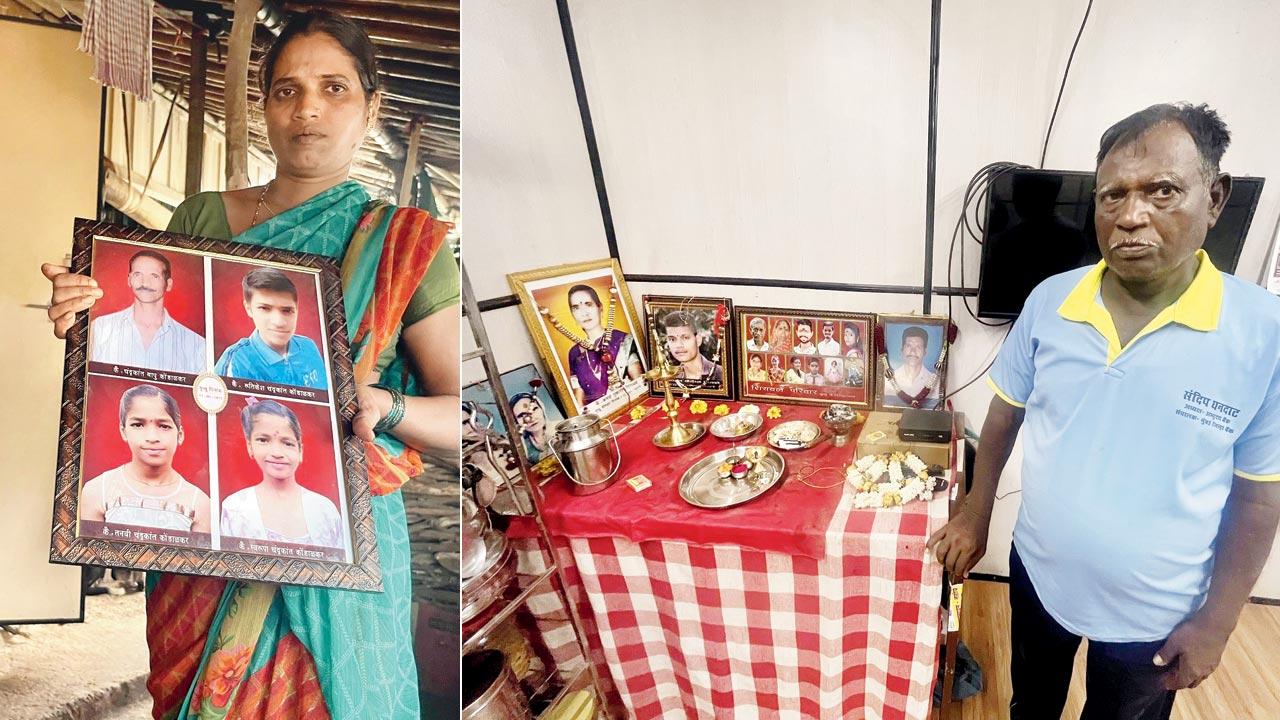 (Left) Hausabai Khondalkar who was buried under the debris for 17 hours and lost her entire family including three children; (right) Tukaram Kashiram, 68, a retired Gujarat police, uncle of Sunil Shiravale standing beside the photographs of the 12 members of their family killed in the landslide on July 22 2021
(Left) Hausabai Khondalkar who was buried under the debris for 17 hours and lost her entire family including three children; (right) Tukaram Kashiram, 68, a retired Gujarat police, uncle of Sunil Shiravale standing beside the photographs of the 12 members of their family killed in the landslide on July 22 2021
Hausabai Chandrakant Khondalkar was among those living at the base of Chanmoda who fled. Her husband Chandrakant and their three children—Rushikesh, Tanvi and Swarupa—stood with other villagers near Duruk Hill when a 20-foot section of it slid down. “I was separated from my children by the impact,” she says. “I hit my back against a roof, and my leg was stuck under the debris. I was unable to see anything, I tried to scream for help, but couldn’t hear my own voice. I thought my children were with my husband, and that I would find them once I was rescued.”
These were her last thoughts as she slipped in and out of consciousness, while being pelted continuously by rain. At some point, a lady pulled her out but she was gone before Hausabai could ask her about her family. “It was late at night and I was still unable to move my legs,” she recounts. “I remained in that position till 8 am the next day.”
When the villagers found her, before the NDRF and other rescue team could arrive, her left leg was injured. She was taken to JJ Hospital, where she underwent multiple surgeries, and was discharged after a month.
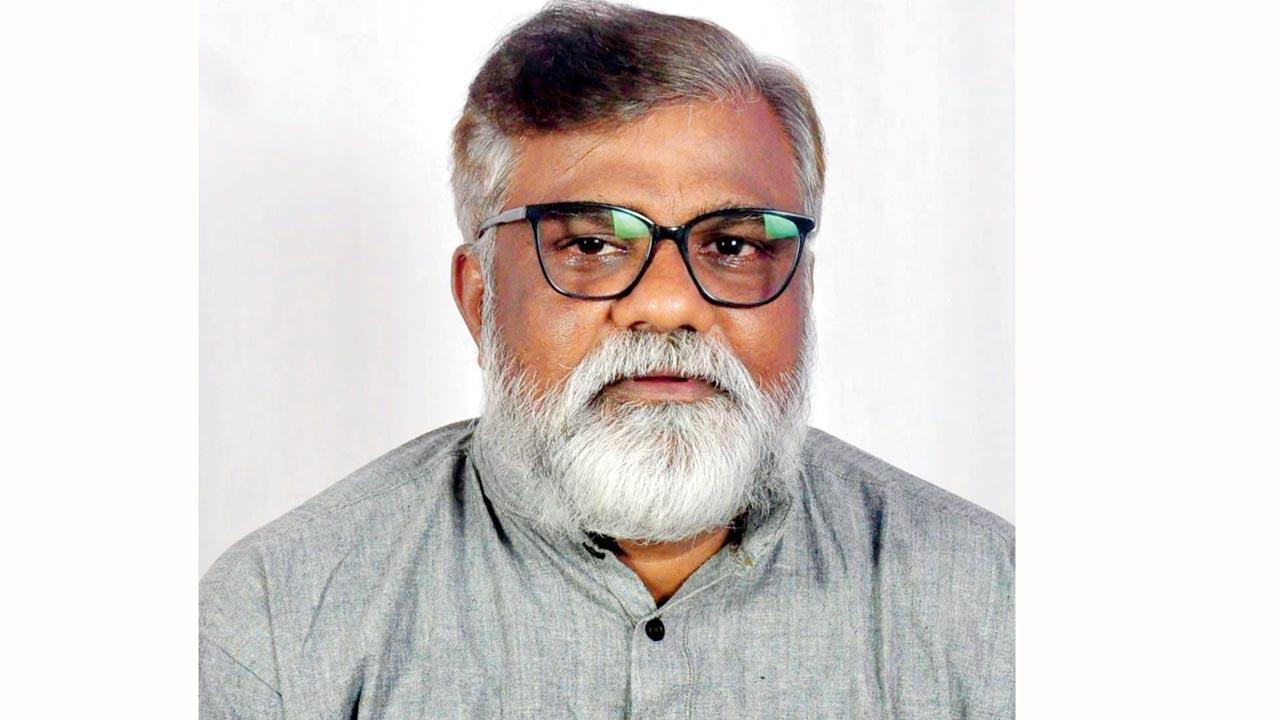 Santosh Thakur, Gram Sanvardhan Samajik Sanstha
Santosh Thakur, Gram Sanvardhan Samajik Sanstha
She was the only one of her family to survive; and one of five survivors to be pulled out of the debris alive. Of these, three passed away during treatment. As she waits for a new house, Hausabai tries to hold back tears: “A house without family is nothing but walls.”
Twenty-two-year-old Swapnil Shiravale was also pulled out from under the tsunami of soil but did not make it. He passed away on August 8, 2021. He had celebrated his birthday on July 22 minutes before the landslide, and had even helped some villagers shift to his home. His brother Sunil, who was away at work at MIDC in Mahad, is the only surviving member of the large family—12 members perished, including his 70-year old grandfather Tulsira and 10-month-old son Parth.
Swapnil’s legs were crushed, and though they were amputated, the gangrene spread and took his life. “All the time he was in hospital,” remembers Sunil, “Swapnil would insist on being taken home and was craving home food. He was on saline and no solid food was allowed.”
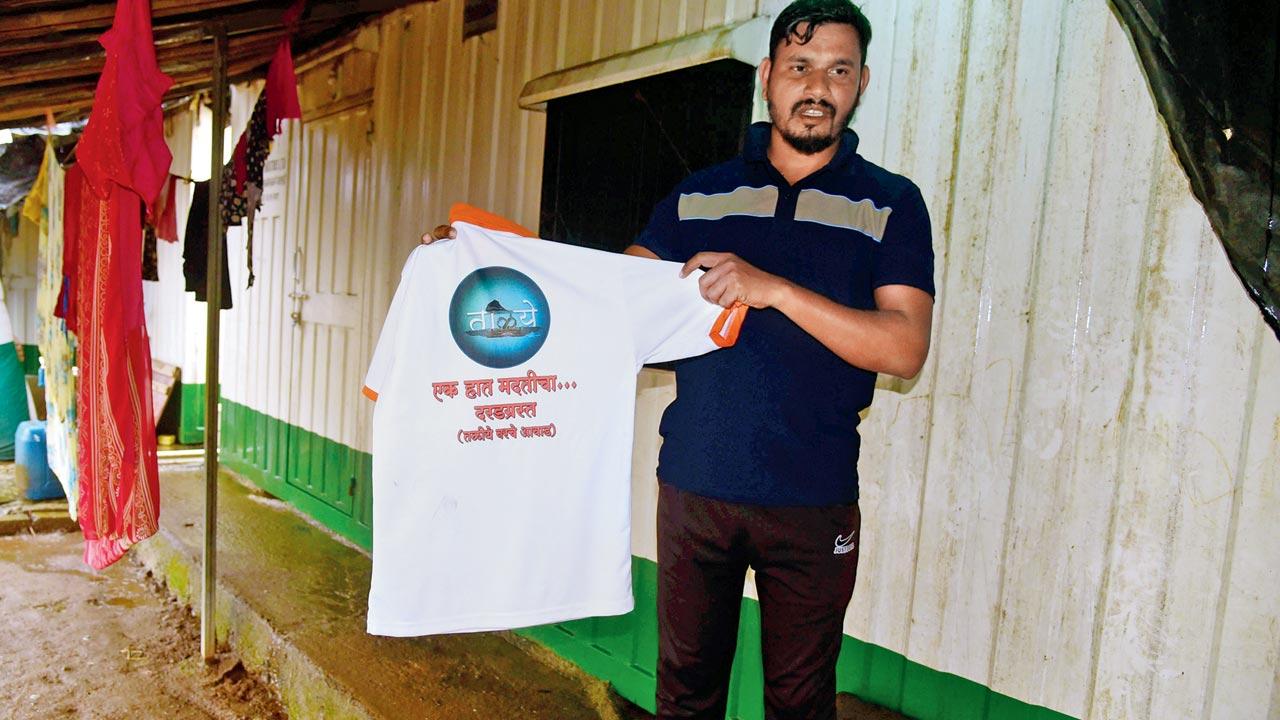 Sunil Shiravale holding the t-shirt which he gifted to Irshalwadi landlside survivors
Sunil Shiravale holding the t-shirt which he gifted to Irshalwadi landlside survivors
Sunil can’t bear to look at Duruk hill. “I don’t want to return to the place that took away my family,” he says. “When I heard about Irsalwadi, the flashback wouldn’t stop. That’s why I met the survivors and we wept together.”
Eighty-year-old Draupadi Janu Shelar continues to live in her ancestral house located close to the landslide-hit area. “I am the third generation living in this house, and now have to vacate it to move into the new one built for us by MHADA. Ours has been declared unsafe and vulnerable due to proximity to the hill.”
Environmentalists say that one of the major causes of landslides is that the trees, whose roots hold loose mud together, are vanishing due to uncontrolled deforestation; afforestation has also halted. Without planting of trees on hillsides, landslides may be a regular phenomenon leaving communities who have lived here for centuries, vulnerable.
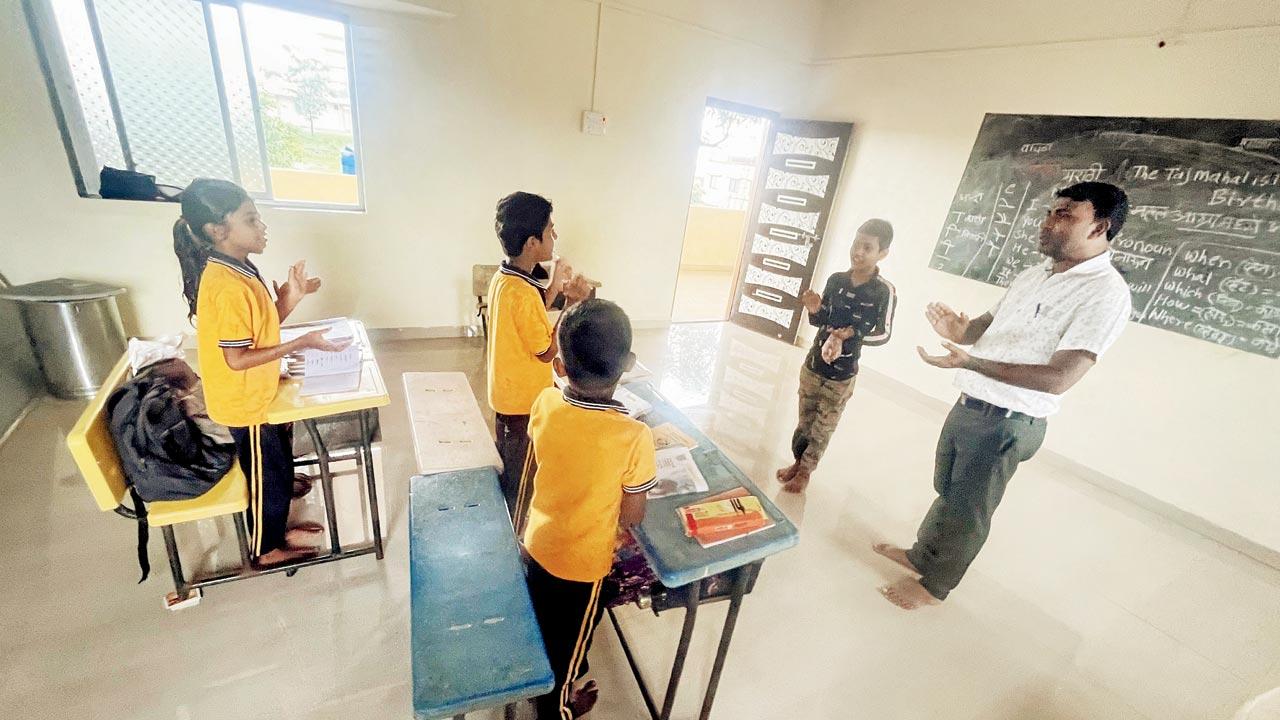 A 75-year-old Zilla Parishad school was a casualty. Opened in 1946, it was where most children from the nearby wadis studied up to class VII. Now, a new primary school has been built closer to where the families will be rehabilitated
A 75-year-old Zilla Parishad school was a casualty. Opened in 1946, it was where most children from the nearby wadis studied up to class VII. Now, a new primary school has been built closer to where the families will be rehabilitated
A 75-year-old Zilla Parishad school was another casualty. Opened in 1946, it was where most children from the nearby wadis studied up to class VII. Now, the Zilla Parishad has constructed a new primary school, closer to the location where the families will be rehabilitated.
But the houses haven’t come up yet. It’s been two years.
“There is a delay on part of the state government and local administration to rehabilitate the survivors,” said Santosh Thakur, founder of Gram Sanvardhan Samajik Sanstha, a NGO that fights for tribal welfare in Raigad district. “The nexus between political henchmen, contractors, suppliers of building materials and labour contractors is also responsible for the delay. The work has been left incomplete work at different stages.”
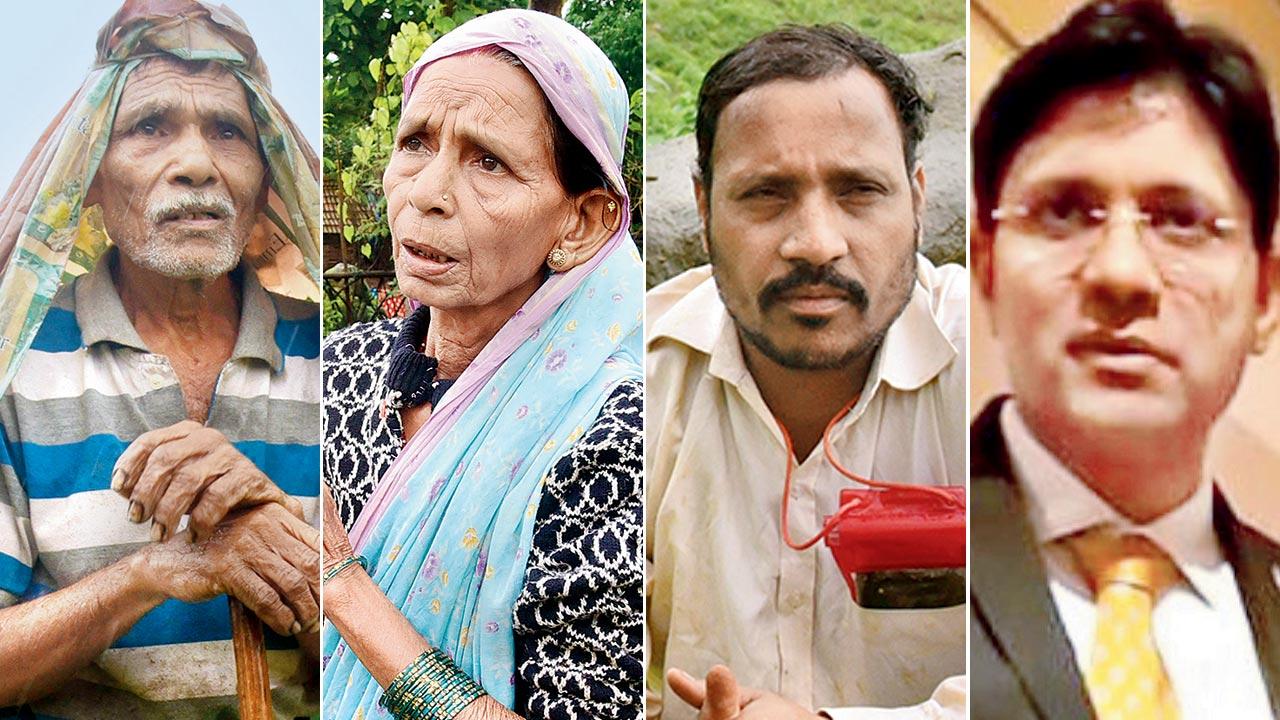 Baban Sakpal, Draupadi Janu Shelar, Sachin Pandey and Satyajit Bade
Baban Sakpal, Draupadi Janu Shelar, Sachin Pandey and Satyajit Bade
Meanwhile, the survivors at Taliye live in the makeshift containers, just metres away from the newly constructed houses. “It’s been over two years,” says Milind Gangawane about the MHADA houses, “but how can we move into homes that don’t have water connection, drainage line, floors and leaky roofs? In the containers, we have electricity and water connection.”
Sachin Pandey has another concern, “What if they disappear and don’t address our problems once we take possession of the houses? That’s why we’ll move only once all the work is completed. The main water storage tank is under construction, the water pipelines are not laid…”
When mid-day visited the area on August 2, construction work was underway. Of the 66 houses, some had leaky roofs and final finishing tasks were incomplete in others. Deep and complex inter-dependency of multiple agencies such as MHADA, ZP, the Irrigation department, MSEB has stalled plumbing, sanitation, waterline connections, setting up of electric meters and construction of the of water tank that will hold 60,000 litres. The Occupation Certificate (OC) for the first phase of the project is also pending.
Sources in the state government admit that the houses should have been handed over by December 2023. They place the blame on extreme rainfall, delay by MHADA in allotting work to contractors, local agitations, supply chain management issues and logistical hurdles. When asked about the defect liability clauses, one official responded: “The liability period under MHADA is five years. They will attend to any issues with construction, and even maintain the sewage collection tanks placed outside the houses.”
“Due to technical and logistical glitches at the site, actual construction work was hampered,” is what Maroti R More, Chief Officer of MHADA, Konkan Board says. Since the project site is at a higher altitude, trucks loaded with steel and raw construction materials were unable to drive to it. “We had to unload the materials at the base,” he says, “then reload them on smaller vehicles to take them to the site. This included approximately three to five tonnes of steel and sandwich concrete panels for internal and external walls.” He says the first phase comprising 66 houses is ready, and awaiting their Occupation Certificates [OCs], which should arrive in the next few weeks. Then, the houses will be handed over to the district administration. “Phase 2 involves 205 houses,” says More, before addressing the incomplete works: “Minor issues have already been sorted out. Two site engineers and the construction staff are handling the complaints.”
And what about missing the December 2023 deadline? “The actual work on site only started in November last year,” he says. Asked whether they would meet the fresh deadline of September 2023, the chief officer takes a pause to say: “Our entire team is working on site to meet the target, and we have given the same deadline to all the contractors too.”
“We have set a deadline of August 15 to iron out all the minor complaints in the existing 66 houses, so that the survivors can shift to their pakka houses,” says Satyajit Bade, Additional Chief Executive Officer of Zilla Parishad Raigad.
Houses not yet homes
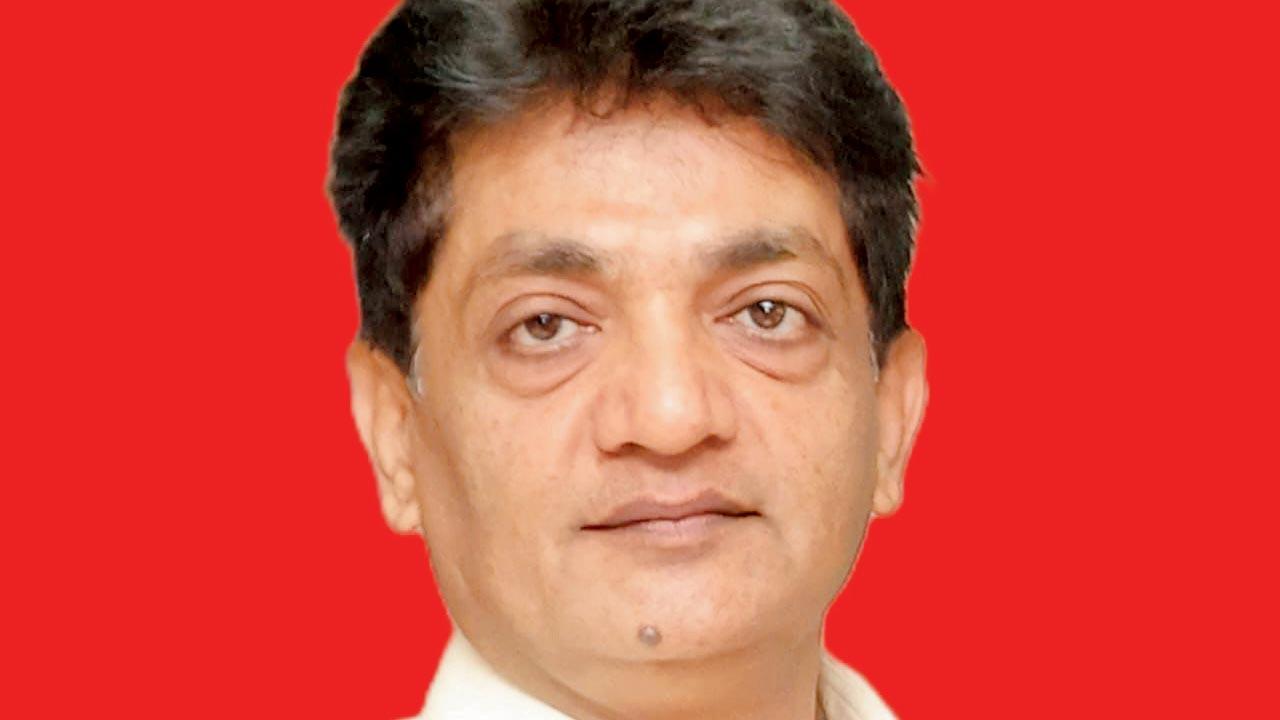 Yogesh Mhase
Yogesh Mhase
This is MHADA’s first rehabilitation project in Raigad district. The 271 houses (600 sqft carpet area each) are designed as per the national building code to be earthquake and fire-resistant, and are fitted with solar panels and steel fabricated roofs. The structures have been tested for durability by technical teams from VJTI and IIT-Bombay.
They are meant for landslide survivors and high-risk villagers. The cost of the entire project was estimated to be around R90 crore, of which approximately R78 crore was to come from MHADA (Konkan Board). Towards the remaining R12 crore, the Zilla Parishad was to pool in R7.50 crore and the rest was to come from the Irrigation department and the MSEB. The Zilla Parishad funds would go towards construction of a school, anganwadi, panchayat office, community temple, gymnasium, internal and external roads, sewage lines, landscaping and beautification and over 100 street lights.
Dr Yogesh Mhase, Raigad District Collector, said, “The project missed deadlines after deadlines, even after two years of the landslide, the survivors are compelled to live in containers even today, which is unfortunate. The initial plan of my predecessor was to handover the key to the landslide survivors (phase 1 has 66 houses) on January 26, (three days after me taking charge of the district). A new deadline was set for April 27, and it was decided to give the keys on May 1 [Maharashtra Day], even that did not happen, and I had to issue two notices under the Disaster Management Act to the concerned agencies for their failure, and I hope that if not August 15, they should be completing the entire project by September 2023.”
When asked if he was anticipating similar delay for rehabilitating Irsalwadi survivors, the collector replied in negative, stating, “In Taliye, different departments are involved from construction to putting up internal and external fixtures, but in case of Irshalwadi the entire project will be manned by CIDCO.”
 Subscribe today by clicking the link and stay updated with the latest news!" Click here!
Subscribe today by clicking the link and stay updated with the latest news!" Click here!







